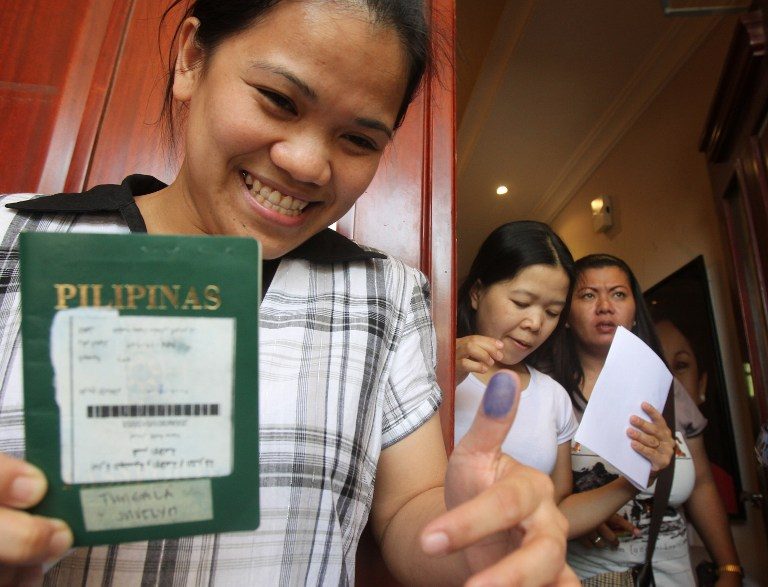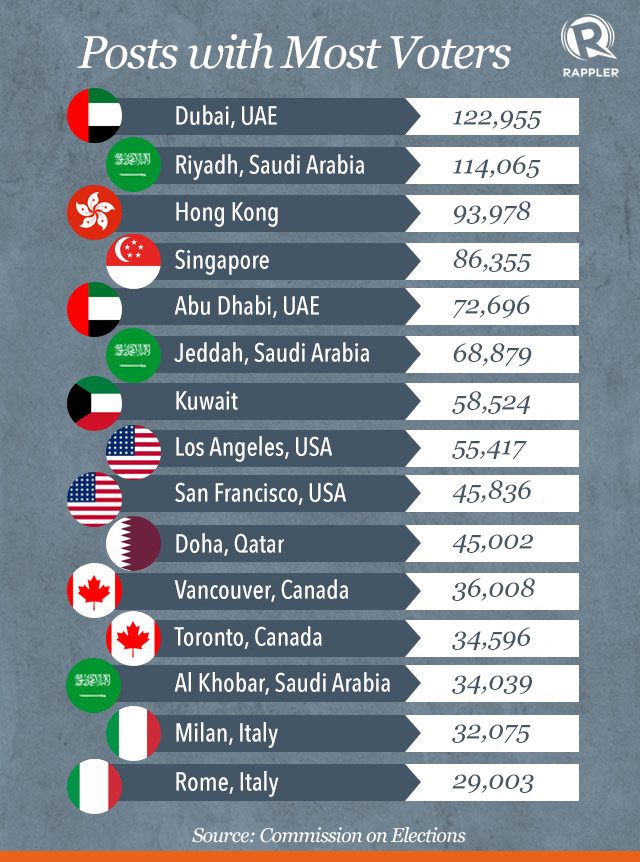SUMMARY
This is AI generated summarization, which may have errors. For context, always refer to the full article.

MANILA, Philippines – A month before elections in the Philippines, Filipinos abroad can already cast their votes and choose who they want as leader for the next 6 years.
Overseas absentee voting (OAV) begins on Saturday, April 9, and will run until May 9.
The Overseas Absentee Voting Act of 2003 enacted the system which allows Filipino citizens residing or working abroad to participate in the elections in the Philippines. Those qualified, however, are only allowed to vote for national candidates such as president, vice president, senators, and party-list representatives.
What are the other things you need to know about the OAV? Rappler profiles the overseas vote:
Biggest number of registered overseas absentee voters in 2016
Since the OAV was introduced in 2004, the number of registered voters has been increasing.
For 2016, the Commission on Elections (Comelec) targeted two million overseas absentee voters or more than double the registered voters in 2013.
The poll body, unfortunately, did not hit its goal when the registration period ended in 2015. It, however, managed to hit an all-time high.
The population of overseas absentee voters for the 2016 polls is at 1,376,067– or 665,116 more than 2013’s 710,951. (READ: Game changers: 1.38 million OFWs begin to vote)
This means that from 2004 to 2016, the number of overseas Filipinos who registered to vote grew by 1,016,779 voters.
The huge increase can be attributed to the “aggressive campaign” of the Commission on Elections or Comelec. The poll body partnered with several government agencies, particularly the Department of Foreign Affairs and its 84 outposts across the world, to introduce several ways for Filipinos abroad to take time to register to vote in the upcoming elections.
The numerous activities – including physical registration booths in airports and online services – contributed to the smooth registration of overseas Filipinos, thus encouraging them to do so.
Most overseas Filipino voters are in the Middle East and Africa
There is a common belief that anywhere in the world, you’re bound to bump into a Filipino. According to latest data from the Commission on Filipinos Overseas, there are at least 10 million Filipinos abroad under 3 categories: 4.8 million are permanent residents, 4.2 million are temporary, and 1.16 million are irregular or those not properly documented.
At least 1.3 million of these Filipinos abroad decided to exercise their “right and privilege” to pick who will lead their home country. Starting April 9, they will flock to Philippine posts in their countries to vote.
Click on a country to see the total number of OFVs registered there, and the posts where they will vote. Conversely, click on the points representing the location of foreign posts to see the mode of voting there: red for automatic, orange for postal (manual), yellow for personal (manual), and black for no elections.
The biggest number of overseas Filipino voters can be found in the Middle East and Africa. Out of the total overseas voter population, at least 593,834 or 43.15% are in countries located in this region.
| REGION | OVERSEAS FILIPINO VOTER POPULATION |
| Middle East and Africa | 593,834 |
| Asia Pacific | 344,857 |
| Northern and Latin America | 275,689 |
| Europe | 161,687 |
| TOTAL | 1,376,067 |
The numbers are not surprising since based on data from the Philippine Overseas Employment Administration (POEA), most overseas Filipino workers (OFWs) were deployed to the Middle East in the past 5 years. Latest figures show that there are 885,541 OFWs in this region alone. (READ: What you need to know about overseas Filipino workers)
In fact, in 2014, 5 out of the top 10 destinations of land-based OFWs were countries in Middle East.
The list of top 15 posts with the highest number of registered voters, meanwhile, is mixed.

Low overseas absentee voter turnout trend since 2004
Despite the significant increase in the number of registered overseas Filipino voters, the actual voters’ turnout may hold back the power of the overseas vote.
In the past election years, the number of voters overseas who actually cast their votes has been dwindling. It was only in 2004 – the first time it was implemented, following the signing of the law in 2013 – when more than half of the number of overseas registered voters actually voted.
| YEAR | REGISTERED VOTERS | VOTERS WHO ACTUALLY VOTED | VOTER TURNOUT |
| 2013 | 710,951 | 118,823 | 16.71% |
| 2010 | 568,733 | 153,323 | 26.96% |
| 2007 | 485,720 | 81,732 | 16.83% |
| 2004 | 359,296 | 233,137 | 64.89% |
Among regions clustered by the Comelec, the Middle East had the lowest voter turnout every election year since 2004, despite its having the highest number of registered voters and OFWs.
Posts in Asia Pacific, meanwhile, consistently registered the highest.
| REGION | 2013 | 2010 | 2007 | 2004 |
| Asia Pacific | 22.50% | 31.87% | 16.71% | 68.60% |
| Middle East | 11.52% | 20.93% | 26.96% | 61.59% |
| North and Latin America | 14.34% | 29.75% | 16.83% | 60.55% |
| Europe | 22.51% | 28.80% | 64.89% | 61.59% |
In 2013, Senator Franklin Drilon – one of the principal authors of the Overseas Absentee Voting Act – urged the Comelec and the DFA to explain the low turnout despite the increase in budget given to both government agencies.
Some of the reasons overseas voters cited for the low voter turnout, despite the one-month allowance given, include distance from consular offices and not being able to get off work after failing to seek permission from employers, among others.
For this year’s polls, DFA and various Philippine embassies are going the extra mile in providing services to voters.
The Philippine Consulate General in Hong Kong, for example, arranged for free shuttle services to bring Filipinos to polling stations. This is on top of the intensive information campaign done through social media. (READ: Free shuttle services available for OFW voters in HK)
In Italy, however, the problem is not accessibility but voter interest and willingness to vote. (READ: PH officials to OFWs in Italy: Go out and vote)
How powerful is the overseas vote?
Liberal Party (LP) tandem Benigno Aquino III and Mar Roxas dominated the overseas vote during the 2010 presidential elections.
Aquino garnered a total of 83,553 votes – 54.5% of the total 153,323 votes cast. Bangon Pilipinas standard-bearer Eddie Villanueva was in distant second with 19,462 votes.
Roxas also won by a landslide in the OAV. He got 83,853 votes against Jejomar Binay’s 18,529 votes from overseas Filipinos. He, however, failed to win the vice president seat and lost to Binay of the United Nationalist Alliance.
In the 2013 senatorial elections, meanwhile, 8 out of the top 12 senators with the most overseas votes eventually got elected. Leading the list was Senator Loren Legarda with 40,651 votes.
Nine of the 12 candidates who got the most number of votes from overseas absentee voters ran under the administration’s ticket – Team PNoy.
| TOP 12 SENATORIAL CANDIDATES BASED ON OAV RESULTS (2013) | ||
| RANK | CANDIDATE | TICKET |
| 1 | Loren Legarda | NPC |
| 2 | Alan Peter Cayetano | Team PNOY |
| 3 | Chiz Escudero | Team PNOY |
| 4 | Grace Poe | Team PNOY |
| 5 | Koko Pimentel | Team PNOY |
| 6 | Bam Aquino | Team PNOY |
| 7 | Sonny Angara | Team PNOY |
| 8 | Dick Gordon | Team PNOY |
| 9 | Ramon Magsaysay | UNA |
| 10 | Risa Hontiveros | Team PNOY |
| 11 | Sonny Trillanes | Team PNOY |
| 12 | Eddie Villanueva | No ticket |
Convince them to vote?
Registered Filipinos abroad now have a month to go to their respective polling stations to cast their votes. They will be the first ones to have the chance to let their voices be heard through their ballots.
Comelec Commissioner Arthur Lim, in a previous interview with Rappler, highlighted the strength of the overseas vote. He argued that the number of overseas Filipino votes is not just a “small lot” and can even determine the next president.
As national bets have started to aggressively campaign overseas, will they also convince our “modern-day heroes” to actually vote? – Map visualization by Michael Bueza / Rappler.com
Add a comment
How does this make you feel?
There are no comments yet. Add your comment to start the conversation.